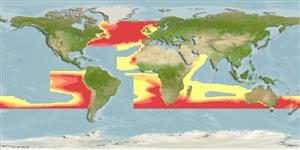Preferred temperature (Ref.
123201): 2.7 - 11.3, mean 7.1 °C (based on 510 cells).
Phylogenetic diversity index (Ref.
82804): PD
50 = 0.5625 [Uniqueness, from 0.5 = low to 2.0 = high].
Bayesian length-weight: a=0.01096 (0.00451 - 0.02668), b=3.10 (2.89 - 3.31), in cm total length, based on LWR estimates for this (Sub)family-body shape (Ref.
93245).
Niveau trophique (Ref.
69278): 3.9 ±0.3 se; based on diet studies.
Résilience (Ref.
120179): Milieu, temps minimum de doublement de population : 1,4 à 4,4 années (Assuming tm=2-4).
Fishing Vulnerability (Ref.
59153): Low vulnerability (10 of 100).
Nutrients (Ref.
124155): Calcium = 34.5 [13.1, 141.8] mg/100g; Iron = 0.386 [0.137, 1.251] mg/100g; Protein = 2.82 [0.00, 6.79] %; Omega3 = 0.283 [0.079, 0.959] g/100g; Selenium = 7.55 [2.25, 30.78] μg/100g; VitaminA = 119 [15, 1,103] μg/100g; Zinc = 0.745 [0.387, 1.553] mg/100g (wet weight);
